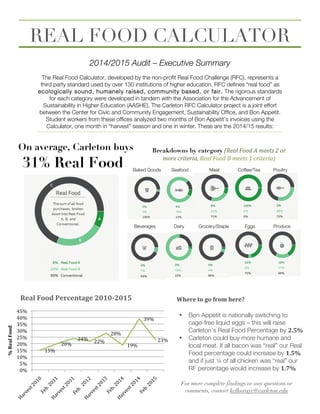
Carleton Real Food Calculator
- 1. Baked Goods Seafood Meat Coffee/Tea Poultry Beverages Dairy Grocery/Staple Eggs Produce 15% 20% 24% 22% 28% 19% 39% 23% 0% 5% 10% 15% 20% 25% 30% 35% 40% 45% % Real Food Real Food Percentage 2010-2015 2014/2015 Audit – Executive Summary The Real Food Calculator, developed by the non-profit Real Food Challenge (RFC), represents a third party standard used by over 130 institutions of higher education. RFC defines “real food” as ecologically sound, humanely raised, community based, or fair. The rigorous standards for each category were developed in tandem with the Association for the Advancement of Sustainability in Higher Education (AASHE). The Carleton RFC Calculator project is a joint effort between the Center for Civic and Community Engagement, Sustainability Office, and Bon Appetit. Student workers from these offices analyzed two months of Bon Appetit’s invoices using the Calculator, one month in “harvest” season and one in winter. These are the 2014/15 results: Breakdowns by category (Real Food A meets 2 or more criteria, Real Food B meets 1 criteria) On average, Carleton buys 31% Real Food REAL FOOD CALCULATOR Where to go from here? • Bon Appetit is nationally switching to cage-free liquid eggs – this will raise Carleton’s Real Food Percentage by 2.5% • Carleton could buy more humane and local meat. If all bacon was “real” our Real Food percentage could increase by 1.5% and if just ¼ of all chicken was “real” our RF percentage would increase by 1.7% For more complete findings or any questions or comments, contact kellowayc@carleton.edu